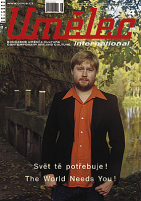| Umělec magazine 2001/4 >> Geometry, Roughly Speaking | List of all editions. | ||||||||||||
|
|||||||||||||
Geometry, Roughly SpeakingUmělec magazine 2001/401.04.2001 Jeffrey A. Buehler | reviews | en cs |
|||||||||||||
|
"20% Sale: Jiří David, Jan Nálevka, Petr Pisařík, Jan Šerých, Tomáš Vaněk, kurátor Jiří Ptáček, House of Art—České Budějovice, 17 Sept. – 21 Oct. 2001
It hits you about 80% from the end: the everyday geometry, roughly hewn. The group exhibition Sleva 20% (20% Sale), curated by Jiří Ptaček, brought Prague talent into the brewing town of České Budějovice in southern Bohemia for a one-month show at Dům Umění (the House of Art). There’s something visceral about going to an exhibition alone and being the only one there — a personal and inexplicable feeling, like a stranger on an empty street handing you a box and telling you to look inside for the gift he’s made for you. And the exhibition allows for a natural unboxing of the curator’s and artists’ intentions: surfaces and shapes in the natural and unnatural world around us, revealed at odd moments and for a variety of reasons. Recent Chalupecký winner Tomás Vaněk has for now set aside his famed stencils for the murky after-images left by muddied sports balls that he hurled against four walls and ceiling. Vaněk must have paid scrupulous attention to what he was doing, as the muddy splats neither drip nor run, and the effect is of standing in a place where a rhythmic and somewhat coordinated violence has taken place. “I threw the balls as hard as I could for over three hours,” he says, with the tennis ball achieving the best results. The idea came to him while he was walking through a passage in an old building near his studio in Prague. The constellation of spots and stains on the surfaces around him — and especially their regularity, which bordered on a seemingly intentional pattern — inspired the work. The atmosphere in the room is one of movement and change, just as the night sky can seem to shift and change and appear entirely different every time you look at it. All of which makes it difficult to understand the placement of Jiří David’s video on the floor in the same room: a visual and auditory intrusion that breaks up the illusion of basketballs and tennis balls flying through the space around you. The monitor grinds out a depressing slowed-down Vivaldi as a hexagon shape spirals and breaks into spinning fragments, an interesting effect achieved through a double recording, a recording of what is being recorded. But only after you enter the next room do you realize that the selection of David’s video is out of place with the rest of the works. And that’s about when you get it, the everyday geometry around you. Jan Šerých has dragged in his own queen-sized steel-framed bed, over which he hangs a painting that reflects the light and dark blues of the bed and duvet. Examined from the front, the image flattens into cold horizontal lines of blue and steel, as hard and static as any screen or monitor. The title, Nic neříkej (Don’t Say Anything), hints at the secrets within the 20% that is left unsaid, and in the end there isn’t much to say about it anyway. It being a cloudy day, the colorful paint splotches and orbs placed on canvas by Petr Písařík in the adjoining room are forced to languish under the blinking and clicking florescent lighting of the space. The lower quarter of the tall double window opposite the painting is filled with balloons. On opening night the right half of the window was as full and colorful as any gumball machine, but in time the balloons broke or deflated, slowly letting the sopping architecture of the central square into the room. Jan Nálevka, the youngest of the exhibited artists, has taped up three rows of four large sheets of paper, on which he printed various geometrical shapes and designs that approximated those of the most popular sports designers and manufacturers, along with what looked like consciously manipulated names like Kerbo and Nake. Only if you are familiar with the Vietnamese clothing stands in Prague will you realize that the work is not intended to undermine the methods of predatory manufacturers looking for ways to permanently sear a design on the collective social psyche. In fact Nálevka merely reproduces what already exists in the more-or-less black-market trade of goods in the city. The symbols and names have to be changed enough to prevent prosecution, but they must still look enough like the original to fool customers into believing they are buying the real article. All of which is a game anyway, as it seems no one is actually fooled, and that often times people are willing to settle for an approximation of the ideal. In the last room along one poorly lit wall Václav Stratil has added a graceful gesture and moment of closure to a simple but somehow satisfying exhibition. His series of nine photos taken from everyday situations of various people show the web of subtle lines and shapes that permeate our lives; from the clothes we wear to the ways in which our bodies conform to our surroundings. In one of the photos Stratil himself stands naked in the shower; the lines of the bathroom tile converge on the various hanging lengths of his body. Not overt in any way, but rather a peripheral geometry that comes into focus when you stop to see the small, roughly comprehensible ways in which the human mind has projected itself on reality, the rest is free of charge. "
01.04.2001
Recommended articles
|
|||||||||||||









Comments
There are currently no comments.Add new comment